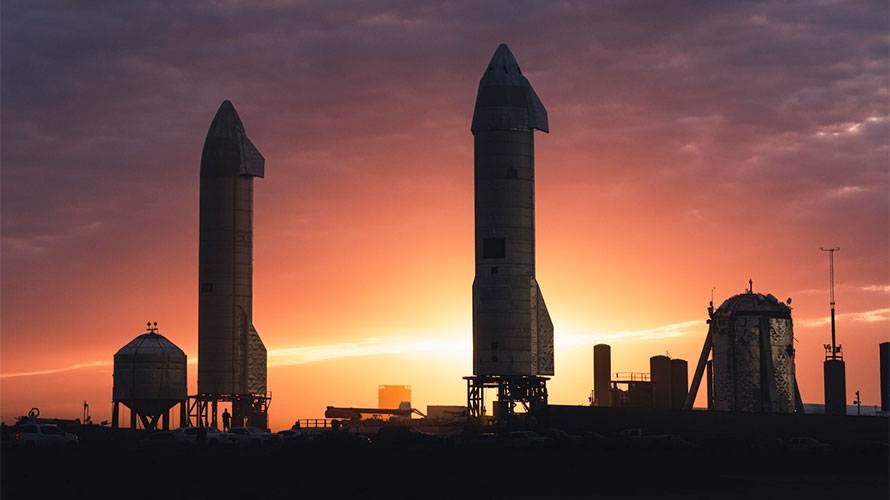
© by Dale Skran, NSS Chief Operating Officer
Image: Starships on the pad at Boca Chica, courtesy SpaceX
The covid pandemic roared through 2021 leaving death in its wake, and at one-point hospitals were using so much liquid oxygen that SpaceX stood down for almost two months due in part to a lack of fuel to launch, as well as potentially a shortage of chips to build Starlink satellites. With everyone struggling in a challenging environment, it would be reasonable to expect only modest achievements from SpaceX in 2021, but that is not how things turned out.
Briefly listing what is almost certainly an incomplete list of SpaceX 2021 milestones:
- January 24: First launch of SpaceX Transporter-1, a new program providing inexpensive ride-shares.
- April 23: Second operational crewed Dragon 2 flight to the ISS (crew of four). This vehicle set a new record for the longest spaceflight by a U.S. crew vehicle, lasting from April 23, 2021 to November 9, 2021, more than 200 days.
- June 3: 2nd Dragon 2 cargo flight under Commercial Resupply Services 2 contract to the ISS/SpX-22. This mission lofted two solar arrays, iROSA 1 and iROSA 2, to the ISS so that they could replace two current aging solar panels.
- June 30: Second launch in the “Transporter” ride-share series, SpaceX Transporter-2.
- August 29: 3rd Dragon 2 cargo flight under Commercial Resupply Services 2 contract to the ISS/SpX-23.
- September 15: Launch of Inspiration4, the first orbital private flight with 4 passengers (did not dock with the ISS).
- November 10: Third operational crewed Dragon 2 flight to the ISS (crew of four).
- November 23: Launch of Double Asteroid Redirection Test (DART) for NASA, the first asteroid deflection mission ever.
- December 9: Launch of the X-ray Polarimetry Explorer (IXPE) for NASA.
- December 21: Fourth Dragon 2 cargo flight under Commercial Resupply Services 2 contract to the ISS/SpX-24.
- 31 total successful orbital Falcon 9 flights, a new record, breaking the 2020 record of 25 orbital launches.
- 17 successful Starlink launches, beating the previous record of 14 Starlink lunches in 2020.
- Three commercial launches (Turksat 5A, SiriusXM SXM-8, and Turksat 5B) in additional to the two Transporter ride-share launches. This understates SpaceX commercial launches since the company is now using Starlink launches as rideshare opportunities as well.
- One launch for the U.S. military, GPS III-5.
- Flew a Falcon 9 first stage for the 11th time, a new record.
- Landed 30 total Falcon 9 first stages successfully, 29 on drone ships and 1 return to the launch site. A single Falcon 9 first stage was lost during its landing attempt.
- Of the 31 Falcon 9 first stage flights, only 2 flew for the first time.
- Total to date for recovery of first stages: 100 – achieved in exactly six years following the first successful recovery effort.
For comparison, in 2021 ULA launched four Atlas V payloads and one Delta IV Heavy. An obvious criticism of SpaceX is that most of their launches were for an internal customer, Starlink. However, the SpaceX commercial/NASA/military total of fourteen is more than twice the ULA launch total of five. The 31 SpaceX launches total more than Russia (22), Europe (5), and Japan (2) combined. Only China at 52 launches bested SpaceX.
A single disappointing area appears again for SpaceX in 2021: No launches of the Falcon Heavy, a deficiency that hopefully will be corrected in 2022.
The above constitutes a remarkable record that any company could be proud of:
- Leading U.S. launch company by a large margin.
- Sole operational US astronaut access to the ISS, with two crewed launches in 2021.
- First commercial “tourist” orbital flight.
- Building a “highway to space” with the Transporter ride-share series and additional ride-shares on Starlink launches.
- Continued to build out the world’s largest satellite network, with more than 1732 satellites in orbit so far.
Additionally, SpaceX won a really big contract in 2021, namely NASA’s Human Landing Systems award: $2.9B to modify a Starship to land on the Moon, with crews arriving in lunar orbit on an SLS launch. It is hard to exaggerate the significance of this decision. Not only is NASA stepping into the future and building on the successful use of commercial launch services to supply the ISS, but NASA committed to in-orbit refueling on a critical mission. NASA has avoided relying on in-orbit refueling to date although this capability is fundamental to our future in space. At long last, NASA has done the right thing in this regard.
But that’s not all folks. SpaceX has been conducting an intensive development and testing effort in Boca Chica, Texas, to bring to reality the Starship/SuperHeavy, a fully-reusable Saturn V class rocket of a totally new design based on the methane-lox Raptor engine. Major tests in 2021 included:
- February 2: 6 minute, 26 second flight to 10km altitude that ended in a crash when an engine failed to restart (Starship SN9).
- March 3: 6 minute, 24 second flight to 10km altitude that landed successfully but exploded 8 minutes later due to damage sustained during the landing (Starship SN10).
- March 30: 6-minute flight to 10km altitude that exploded about 600m up just prior to a landing attempt (Starship SN11).
- May 5: 5 minute, 59 second flight to 10km altitude that landed successfully (Starship SN15). Note that SN12, SN13, and SN14 were discarded or never fully assembled since they were superseded by the more advanced SN15.
Since then, SpaceX has constructed additional Starships and various test versions of the “Superheavy” booster, along with an elaborate launch tower with arms to catch the returning booster. Currently SpaceX appears to be waiting for FAA permission for an orbital launch while conducting a variety of ground tests and static fires of various Starships and SuperHeavies.
There is just no getting around it—SpaceX had a very good 2021, almost certainly the best ever for the company. 2022 holds out the potential to be even better, featuring:
- A new record number of total launches.
- A single Falcon 9 first stage flying for 12 or more times.
- As many as five Falcon Heavy flights.
- NASA’s PSYCHE mission to a metal rich asteroid on a Falcon Heavy.
- Two NASA crews to the ISS PLUS two crewed Axiom missions to the ISS.
- Two Intuitive Machines flights to the Moon as part of the NASA CLPS (Commercial Lunar Payload Services) program
- A large number of Starlink launches.
For any normal company, the above would be a fantastic level of achievement, but for SpaceX is isn’t even the most important goal. All eyes will be on Boca Chica, Texas, as SpaceX starts a run to glory as it attempts for the first time to accomplish an orbital StarShip/SuperHeavy launch. The announced flight plan calls for expending both the first and the second stage, so the pressure is on to boost Raptor engine production to support an ambitious test program.
Probably the greatest risk to SpaceX’s 2022 ambitions lies in obtaining permits to launch Starship/SuperHeavy and to continue to orbit Starlink satellites. Recent FAA hearings on launching from Boca Chica suggest that opposition to SpaceX activity there is growing. Additionally, an alliance of ground-based astronomers and competing data communications vendors will almost certainly continue to raise the alarm about alleged interference from the expanding Starlink network.
SpaceX is constructing two ocean launch platforms, and has just announced plans to build two more StarShip/SuperHeavy launch pads at Cape Canaveral. The announced intention is to switch as rapidly as possible to launching a new generation of larger and heavier Starlink satellites on the less expensive, more capacious Starship/SuperHeavy. SpaceX may well fall short of its greatest ambitions in 2022, but I am looking forward to seeing a Starship in orbit!!!



















